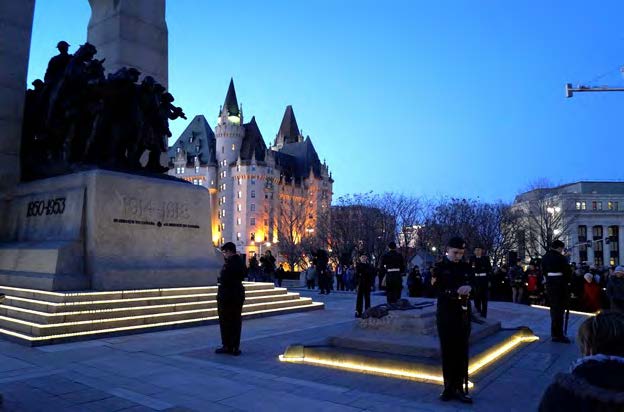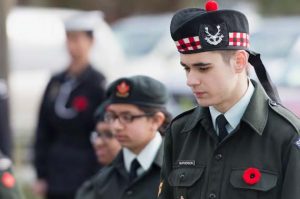IN 2010 CANADA marked the end of an era on Vimy Ridge Day with the passing of our last First World War veteran. Youth were challenged to take up the Torch of Remembrance so that the memory of those who served between 1914 and 1918 would never fade.
The year 2011 marked the beginning of a new era, when The Royal Canadian Army Cadet Corps (RCACC) commemorated the Battle of Vimy Ridge for the first time. With 300 cadets on parade that evening, they held the very first official Army Cadet Battle of Vimy Commemoration and it was also the very first overnight vigil in Ottawa. The Ottawa cadets felt strongly about commemorating the troops of 1917 in a similar way to what our soldiers had experienced. One hundred years ago, on April 8, Canadian soldiers had to wait in the tunnels of Arras for 24 hours until adverse weather conditions passed and they could storm the ridge the next day. Moreover, cadets from coast to coast also rose to this new challenge of commemoration and organized their own personal corps events.
April 8, 2017 was an important day as it marked the 100th anniversary of this battle. The Army cadets in Ottawa were once again called to carry the Torch of Remembrance. Parades and special commemorative events were organized by numerous corps in each province and were attended by dignitaries, veterans, organizations and members of the community. Some even planned the reenactment of the battle. In Peterborough, Ontario, cadets from the 2672 Hastings and Prince Edward RCACC planted over 600 ceramic trillium flowers to honour Canada’s fallen at Vimy Ridge at the local cenotaph. Sixteen red trilliums were planted to honour the Peterborough area soldiers who fell in the battle, while the remaining white flowers commemorated the locals who died during the Great War. One hundred cadets from Manitoba will visit the Vimy memorial in May; several other corps will also make pilgrimages this year to mark the battle’s centenary.
It is at moments like these where our youth really come to realize why such commemorative events occur, and why they should be proud to be part of them. To Cadet CWO Michael Robichaud, of the 2870 Royal Canadian Dragoons RCACC, who served as master of ceremony at Ottawa’s Army Cadet ceremony, said of his experience, “Often times, people overlook events or an act because it does not concern them, because they don’t feel as though they are involved with whatever happened. I used to think like that as well, as we all do when we are younger, or simply lack the information to truly understand the situation.”
Robichaud continues: “See, when I participated in the Vimy vigil this time last year, I didn’t do it for the same reasons as I did it this year; it meant something different for me as I had been given an opportunity to learn. It was during my summer camp last year, as part of the first group participating in the Army Cadet battlefield tour, that I finally properly understood why we do these commemoration events. I learned so much that summer, but what I retained most importantly is that the actual numbers of the fallen is not what truly counts.”
Robichaud explains that, “throughout our history lessons, wherever they may come from, such as school or cadets, or literature, we are taught that these numbers such as the 3,598 fallen soldiers of this battle are facts, but in reality, the number, though important, is only part of the story.”
Through his experience in the Army Cadets battlefield tour last summer, Robichaud learned that “What really matters is the life, the story that is behind each number representing each fallen soldier. Every single one of them was a brother and a son to so many affected families, maybe a teacher or mentor to others, a loving husband or father to a happy family, their families left behind in fear of losing a loved one. It is they, each individual, whom we must commemorate, not the number. We must take the time to thank those whose story enabled our own stories to take place, our own families to stay safe. It is their personal sacrifices and actions we must take the time to honour. Though a sombre and mournful time, it is important to thank them for what they did, to remember them and their story … and in that we must always remember them.”
Through his experience in the Army Cadets battlefield tour last summer, Robichaud learned that “What really matters is the life, the story that is behind each number representing each fallen soldier. Every single one of them was a brother and a son to so many affected families, maybe a teacher or mentor to others, a loving husband or father to a happy family, their families left behind in fear of losing a loved one. It is they, each individual, whom we must commemorate, not the number. We must take the time to thank those whose story enabled our own stories to take place, our own families to stay safe. It is their personal sacrifices and actions we must take the time to honour. Though a sombre and mournful time, it is important to thank them for what they did, to remember them and their story … and in that we must always remember them.”
This demonstrates the influence such experiences can have on the younger and upcoming generations and how these events can truly touch them on a personal level. The impact is even more profound when they are given the opportunity to travel overseas to tour the many monuments, cemeteries and battlefields, where they can see for themselves and retrace the steps of the thousands of soldiers who walked before them and fell in battle. Cadets and their commitment to commemorate military honours will ensure that soldiers’ sacrifices are not forgotten. By having an appreciation for military and regimental history, Army Cadets will continue to relate to the significant battles Canadian soldiers participated in.
Every year, as Army Cadets gather for the Vimy vigil, our youngsters on parade come to realize that they are not much younger or older than many of the fallen Canadians who perished that day. But they also realize that their story, their life, and their sacrifice must be remembered.
Cadets will continue to commemorate the Battle of Vimy just as they do Remembrance Day. And each year, as new recruits come through the cadet ranks, more of them will understand the significance of these events and the importance of never forgetting the ultimate sacrifice that was made by so many Canadians 100 years ago.



